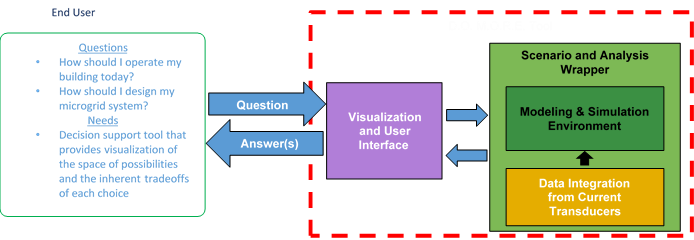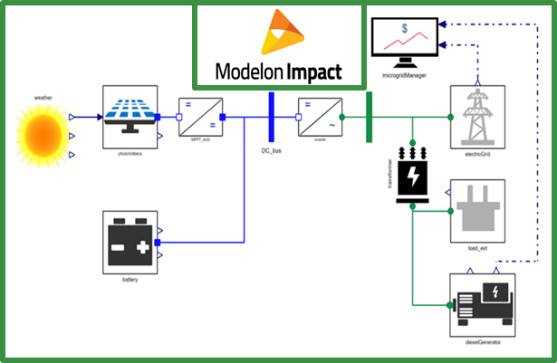The Future of Microgrids: Georgia Tech Researchers Prove Microgrid Design With a Digital Twin, Powered by Modelon

The Aerospace Systems Design Laboratory (ASDL) at the Georgia Institute of Technology, was founded in 1992 to bridge the gap between academia and industry research perspectives, and it has grown to be one of the nation’s premier entities for aerospace systems and complex design. ASDL’s “Grand Challenge” class projects are open ended problems driven by real needs of industry and government partners. Their main goal is to apply theoretical principles in aerospace systems engineering through a team-based class project and to provide a chance for the students to present to and interact with high-level government and industry representatives at the annual ASDL External Advisory Board meeting.
One of this year’s Grand Challenge teams has been exploring methods for effective building energy management through use of microgrid architectures and allowing for “what-if” scenario-based analyses to be conducted for a variety of infrastructure and operating conditions changes at both the microgrid and building levels. The use of Modelon’s software technology has been instrumental in supporting the optimization of microgrid design for cost efficiency, resiliency to external factors (such as weather or power outages), and environmental impact, while leveraging ASDL’s past efforts in both demand and supply side modeling provides the foundation of a Digital Twin (DT) for building energy management purposes.
In the past half-century, the consumption of energy in the United States has nearly doubled and is expected to continue to rise in the future. As a result, power utility companies have had to dramatically increase power production to meet this rising demand. With only 11% of U.S. energy consumed sourced by renewables, the environmental impact of this demand is significant, while aging transmission lines and transformers have led to a seven-times increase in the number of weather-related outages in the last 20 years, costing Americans between twenty and $50 billion annually.
Distributed Generation (DG) is a potential solution to improve power reliability and sustainability, through reduction of peak power requirements, provision of ancillary services such as reactive power, and improvements in power quality. Hence, building managers have begun to integrate microgrids into their building energy management.
What is a Microgrid? In short, microgrids consist of local storage and generation of power that provide owners with increased flexibility and control over their power consumption.
With the amount of microgrids increasing there is a resulting need for decision-support capabilities. Recommended strategies for effective energy management allow for what-if scenarios analyses to be conducted for varying infrastructures and operating conditions – at both microgrid and building levels. Effective management of energy resources has been the subject of research, with most current methods addressing the problem from two aspects: demand- and supply-side optimization.
- Demand-side approaches seek to effectively regulate energy demand by splitting loads (e.g. into critical, curtailable, and reschedulable), and then implementing strategies on when to effectively consume power for peak/average power consumption ratio reduction, or when to buy exclusively from the grid at a lower price.
- Supply-side management will regulate timing of drawing power from local generation (solar panels, diesel generators, wind turbines, etc.), power storage, and when to sell/buy power to/from the larger grid.
Our Grand Challenge: Optimize a Microgrid for a Corporation HQ
 The goal of the Grand Challenge team was to create a parametric decision-support environment that assists specifically in operations optimization and infrastructure planning for a building-microgrid system of systems. This was demonstrated through three case studies focusing on electric vehicle charging capability, operations optimization, and infrastructure planning. The baseline configuration has been a physical building that is connected to a microgrid, for which also actual power consumption data has been available. Hence, with these resources made available a building-microgrid Digital Twin development approach was formulated, to enable rapid and parametric tradeoffs, as well as to calibrate the models against the real-world energy performance datasets. A building digital twin could be calibrated in real-time with the building to provide day-to-day recommendations for the effective management of a building and forecast the impact of planned changes in infrastructure on energy management. Performance metrics for strategies will include energy resiliency, or ability to island from the grid, cost efficiency, and environmental impact, measured in the carbon footprint of the building power sourcing.
The goal of the Grand Challenge team was to create a parametric decision-support environment that assists specifically in operations optimization and infrastructure planning for a building-microgrid system of systems. This was demonstrated through three case studies focusing on electric vehicle charging capability, operations optimization, and infrastructure planning. The baseline configuration has been a physical building that is connected to a microgrid, for which also actual power consumption data has been available. Hence, with these resources made available a building-microgrid Digital Twin development approach was formulated, to enable rapid and parametric tradeoffs, as well as to calibrate the models against the real-world energy performance datasets. A building digital twin could be calibrated in real-time with the building to provide day-to-day recommendations for the effective management of a building and forecast the impact of planned changes in infrastructure on energy management. Performance metrics for strategies will include energy resiliency, or ability to island from the grid, cost efficiency, and environmental impact, measured in the carbon footprint of the building power sourcing.
 The baseline building energy infrastructure under consideration integrates elements of a microgrid as well as an extensive array of solar cells and a 1MWh battery array. It includes power sensors collecting data about its total power usage, various heating, ventilation, and air cooling systems, variable air volume boxes, a data center, and a solar irradiance tracker placed outside the building. Modelon Impact, coupled with their microgrid components implemented in the Modelica language, has been the backbone of the M&S environment development. This library was the source for validated physics-based models, as well as optimization algorithms to support rapid exploration of more efficient operation protocols, through leveraging fast simulation execution times. ASDL’s surrogate modeling techniques have been key in reducing simulation run times, further enabled by the use of a Python API for prerecorded data port-ability of Pandas and Tensor flow libraries, which have allowed for 50 or more on-site sensor readings from a 365 day time span.
The baseline building energy infrastructure under consideration integrates elements of a microgrid as well as an extensive array of solar cells and a 1MWh battery array. It includes power sensors collecting data about its total power usage, various heating, ventilation, and air cooling systems, variable air volume boxes, a data center, and a solar irradiance tracker placed outside the building. Modelon Impact, coupled with their microgrid components implemented in the Modelica language, has been the backbone of the M&S environment development. This library was the source for validated physics-based models, as well as optimization algorithms to support rapid exploration of more efficient operation protocols, through leveraging fast simulation execution times. ASDL’s surrogate modeling techniques have been key in reducing simulation run times, further enabled by the use of a Python API for prerecorded data port-ability of Pandas and Tensor flow libraries, which have allowed for 50 or more on-site sensor readings from a 365 day time span.
We’ve been impressed with the simulation capabilities of Modelon’s tools, and as a technical partner, the Modelon team has been providing invaluable support in this project. Modelon’s subject matter experts helped our team move faster than we thought possible, having supported us with ramping up the learning curve with offering tutorials, sharing of valuable insights, know-how and best practices. Their team of experts was made available from offices across the world, within hours of our initial request. We’re excited to see this partnership grow and make greater impact.
About the Aerospace Systems Design Laboratory @ Georgia Tech
ASDL has over 25 years of experience in executing research projects for many government and industrial partners and has grown to an organization that has performed $100M worth of research in new methods and tools in the past 10 years and is home to 250 researchers that include research faculty and Masters and Ph.D. students. In the past 25 years, ASDL has developed signature methods to streamline the integration of parametric simulation tool sets and enable significant runtime improvements that facilitate large-scale design space exploration and optimization under uncertainty. ASDL is part of the Daniel Guggenheim School of Aerospace Engineering at the Georgia Institute of Technology.
More about ASDL @Georgia Tech can be found at: http://www.asdl.gatech.edu/.
Also, follow @asdl_gatech on Instagram and Twitter to keep up with ASDL!


